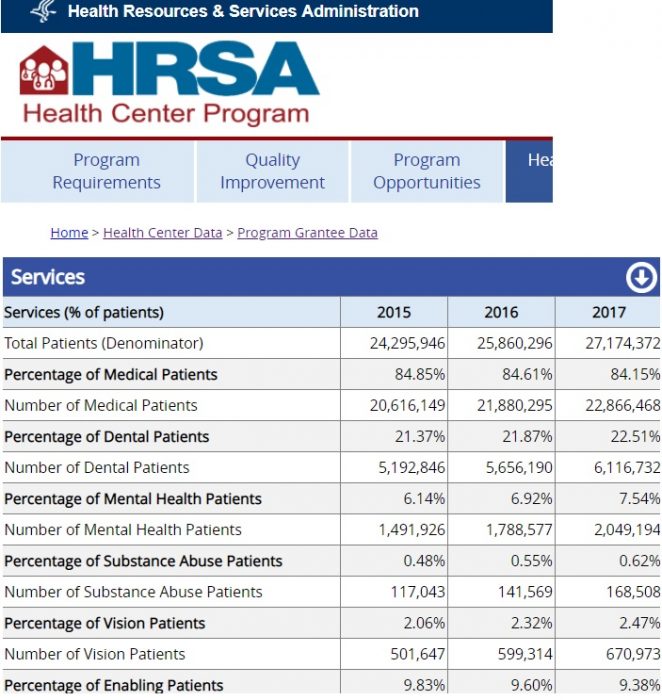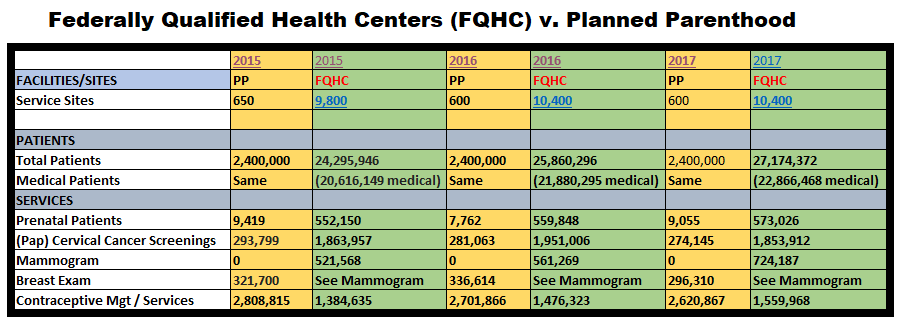Planned Parenthood claims 75 percent of its patients have incomes at or below 150 percent of the federal poverty level. Recent HHS rule changes put in place by the Trump administration regarding TitleX family planning funds threaten to remove tax dollars from Planned Parenthood as long as it continues to commit abortions in the same facilities where it dispenses birth control. Supporters of the changes argue that poor and low-income men and women should not be forced to visit abortion facilities in order to access health care, nor should taxpayer dollars be used to prop up abortion facilities. And that’s what has been happening, as this video explains.
Despite this, supporters of the abortion corporation falsely claim that if Planned Parenthood is defunded, Federally Qualified Health Centers (FQHC), as identified by the federal Health Resources and Services Administration (HRSA), would not be able to handle the influx of patients, a claim previously debunked.
There are vast differences between community health centers (which provide comprehensive health services to women and families) and Planned Parenthood, whose president called abortion the corporation’s “core mission.”
FACILITIES
Planned Parenthood (PP) facilities have been decreasing nationwide, while FQHC sites are increasing:
- 2015: Planned Parenthood operated 650 facilities while there were 9,800 FQHCs.
- 2016: PP reported 600 facilities to FQHCs recorded 10,400.
- 2017: PP still reported 600 facilities and FQHCs remained 10,400.
- 2018: PP still reported 600 facilities while FQHCs rose to 12,000.
PATIENTS
Planned Parenthood reports show the abortion vendor served 2.4 million clients annually in 2015, 2016 and again in 2017. But this is a decrease of 700,000 patients (nearly 23 percent) from the 3.1 million PP boasted in 2006.
Meanwhile, between 2015 and 2017, patients at FQHCs increased nearly 12 percent — to over 27 million:
- 2015: FQHCs served 24,295,946, of which 20,616,149 were medical clients.
- 2016: FQHCs served 25,860,296, of which 21,880,295 were medical clients.
- 2017: FQHCs served 27,174,372, of which 22,866,468 were medical clients.

FQHC patients 2015 to 2017 (Image 2017 HRSA)
Mammograms/Manual Breast Exams:
Planned Parenthood does not perform mammograms, while FQHCs do. Instead, PP offers manual breast exams.
- 2015: PP recorded 321,700 manual breast exams, while FQHCs performed 521,568 mammograms.
- 2016: PP recorded 336,614 manual breast exams, while FQHCs performed 561,269 mammograms.
- 2017: PP recorded 296,310 manual breast exams, while FQHCs performed 724,187 mammograms.
Figures from Planned Parenthood’s most recent report (2017-2018) reveal that manual breast exams there have decreased nearly 73 percent (72.73%) from a high of 1,086,654 in 2000. In the past ten years, breast exams have fallen 65 percent (65.19%), from 851,232 in 2007 to 296,310 in 2017.
Pap Tests/ Cervical Cancer Screenings:
Since 2004, Pap tests at Planned Parenthood have declined nearly 77 percent (76.84%) from a high of 1,183,692.
- 2015: PP recorded 293,799 Pap tests, while FQHCs performed 1,863,957 cervical cancer screenings.
- 2016: PP recorded 281,063 Pap tests, while FQHCs performed 1,951,006 cervical cancer screenings.
- 2017: PP recorded 274,145 Pap tests, while FQHCs performed 1,853,912 cervical cancer screenings.
In 10 years, PP’s Pap tests decreased nearly 72 percent (71.70%), falling from 968,682 in 2007 to 274,145 in 2017.
Contraception:
On paper, Planned Parenthood’s contraception services appear to out perform those provided at FQHCs. But when you look closely, you see that between 2015 and 2017, while Planned Parenthood’s contraception services dropped nearly seven percent (6.69%), FQHCs contraception services increased by nearly thirteen percent (12.66%).
In fact, in just one year, (2016 to 2017) FQHC’s services increased by 83,000 to while PP’s decreased by 80,000. See chart below.
Since 2009, contraception services at Planned Parenthood have fallen nearly 35 percent (34.63%) from a high of 4,009,549. In 10 years, contraception services dropped nearly 33 percent (32.63%) from 3,889,980 in 2007 to 2,620,867 in 2017.
Live Action News analyzed data in 2017, which looked at Planned Parenthood centers, Federally Qualified Health Center sites, and Title X facilities for 2015, and found:
- 60 percent of FQHCs offered contraception to at least 10 female clients.
- 361 counties out of 3,142 counties had both a Planned Parenthood and a FQHC site.
- 580 counties had neither.
- Out of the 2,201 remaining counties, 54 had no FQHC site and 2,147 had no Planned Parenthood (table 3/page 7).
- In all, Planned Parenthood centers were located in just 415 U.S. counties while 1,719 counties had FQHC sites.
At that time, FQHC sites outnumbered Planned Parenthood in counties that provide contraception in every state except Connecticut, Minnesota, and the District of Columbia.
READ: VICTORY: Court rules that Ohio can defund Planned Parenthood

FQHC V Planned Parenthood 2015-2017
Prenatal Care:
Undercover investigations conducted by Live Action have revealed that abortion — not prenatal care — is the primary service Planned Parenthood offers to pregnant clients.
- 2015: PP recorded 9,419 unspecified prenatal services, while FQHC’s served 552,150 prenatal patients.
- 2016: PP recorded 7,762 unspecified prenatal services, while FQHC’s served 559,848 prenatal patients.
- 2017: PP recorded 9,055 unspecified prenatal services, while FQHC’s served 573,026 prenatal patients.
Planned Parenthood’s prenatal care services have dramatically decreased from where they were just a few years ago. According to PP’s most recent annual report (2017-2018), prenatal care services decreased nearly 71 percent (70.88%) from a high of 31,098 in 2010. In 10 years, prenatal care dropped 17 (17.03%), from 10,914 in 2007 to 9,055 in 2017.
Abortions:
Live Action News has documented repeatedly that Planned Parenthood’s clients and services are decreasing, while abortions and taxpayer dollars continue to increase. In 2017, Planned Parenthood committed 332,757 abortions, the highest number committed by the corporation since 2011. In ten years, abortions at Planned Parenthood rose nine percent (8.98%) from 305,310 in 2007.
In addition:
- Abortions are increasing at Planned Parenthood despite a decline nationally.
- Planned Parenthood commits one-third of abortions in the U.S., over 900 abortions every single day.
- Planned Parenthood commits 117.54 abortions for every adoption referral.
Watch the video below for more on what “adoption referrals” actually mean at Planned Parenthood:
Planned Parenthood masquerades as a primary health care organization, when they are actually an abortion corporation whose market share of reported abortions exceeds 35 percent of the national market share. It is time to divert funds from this abortion behemoth into life-affirming community health centers that can offer poor and low-income patients the comprehensive care that they deserve.
Editor’s Note, 3/13/19: Edited to add explanation of contraception services.
“Like” Live Action News on Facebook for more pro-life news and commentary!







